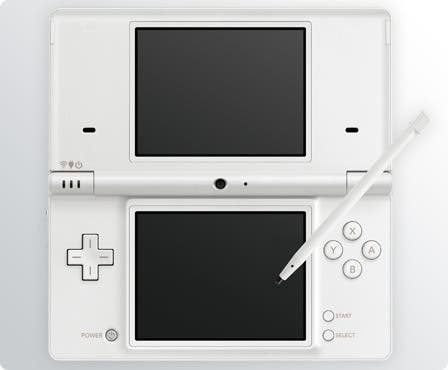Nintendo DSi
Bright young things.
"For mobile phones and digital cameras, manufacturers have been increasing the number of pixels in order to appeal to the consumers," Nintendo president Satoru Iwata pointed out when the DSi was announced. "However, we have taken almost the opposite approach. We cannot boast about the resolution, as the camera for DSi has a 0.3 megapixel resolution."
Iwata's justification, speaking to the Japanese press, was that the DSi can apply around a dozen special filters to change colours and add effects. "We would like to propose with DSi the entertainment value of playing with and enjoying visuals and sounds by using these functions in more proactive and fun ways in your daily activities," he said.
For those still struggling to comprehend a 0.3 megapixel camera - even though there are actually two - it's worth returning to something Shigeru Miyamoto told Channel 4 on a recent visit to London: "Nintendo's mission is to take advantage of improving cheaper technology to create reasonable and affordable entertainment."
As we observed at the time, 'the lateral thinking of withered technology', espoused by Game Boy creator Gunpei Yokoi, is the inspiration for much of Nintendo's current success. The GameCube may have been withering technology, but it was the lateral thinking part that got Nintendo out of trouble with the DS and Wii, and the company hasn't forgotten it.
In other words, it's not surprising to see a small, cheap camera - two small, cheap cameras, in fact - attached to the new DS handheld, because Nintendo isn't trying to compete with digital cameras and mobile phones. Like the two screens, the stylus and the microphone before them, the cameras are there for playing with.
For that, we get a cute, chunky photo package that allows you to switch between the two cameras, take still snaps and play around with them, framing people in hearts, kaleidoscoping heads, and storing images on a Brain Training-style daily calendar to build up a picturebook. Like PictoChat, it feels like an example of what can be done, rather than the beginning and end of the process.

Likewise, the music player software allows you to record 18 voice samples, and watch visualisations as you listen to AAC files. Again, it's about playing with sounds. The absence of MP3 support is limiting, and limited compared to mobile phones and other music players - but Nintendo would argue, again, that it isn't competing for that money, and perhaps even that it needs to make that clear.
One of the surprises that greeted DSi buyers was the 256MB of onboard memory, onto which you can flash over 400 of the cameras' 640x480 photographs (there's also SD card support). But the other thing the memory's for is storing stuff from the DSi Shop. Like the Wii, data is counted in "blocks" - 1,024 of which make up the 256MB - and for now you can download the free Opera web-browser to occupy the first 85.
More software will follow at the end of the year, when the DSi Shop starts to host original, downloadable games, in the same vein as WiiWare - something that has already sparked enthusiasm among developers. If the cameras are Nintendo at its most craftily backward, the shop is the company's concession to the brave new world.
That said, it still gives Nintendo the chance to look back, and we would love to see Virtual Console compatibility rolled out at some point. Different control inputs would get in the way for N64 games, but surely the Super Nintendo, Mega Drive and others are possible.
In the meantime, existing DS games benefit from a pair of slightly larger (8 per cent) screens, and a new higher brightness level (5) that noticeably outshines the DS Lite - gorgeously in the case of vividly colourful games like Elite Beat Agents.

Whether the additional screen space makes any tangible difference to gameplay is harder to gauge. Logic dictates that slightly bigger icons and text will be beneficial, but we didn't feel any less comfortable playing EBA or Phantom Hourglass on either the DSi or the DS Lite. The screen on the DSi has the same slightly rough finish that holds up the stylus tip, and the stylus itself is slightly longer, although the tip is the same size.
But there are subtler changes than the screens, of course. The new chalky matte finish, inside and out, reduces thumbprints, and with sharper corners gives the DSi a functional, Wii-like low profile.
The slider power button has gone from the side, too, replaced by a clicky circular power button on the bottom-left side of the lower screen, so you'll no longer switch the DS on or off by accident in your pocket or bag. When the DSi is on, a quick click takes you to the new Wii-inspired dashboard, while holding it switches off. The power and battery LEDs move to the left side of the hinge, too, and there's a new blue one for Wi-Fi activity, since Wi-Fi can now be disabled to conserve battery. Each has an accompanying icon on the inside of the top-screen. Elsewhere, the DS Lite's six pinholes for each speaker are replaced by a pair of horizontal slits.
The other buttons are different, too. Start and Select are small, mini mint-style clicky circles, and the volume control has been relocated from the bottom of the unit to the left side, and transformed from a slider into a clicky +/- control. More significantly, back on the inside, the d-pad is clicky and the face buttons are shallower.








